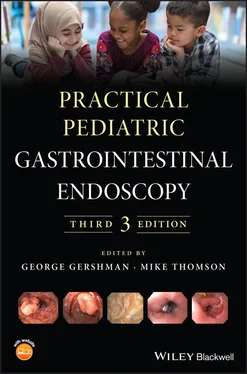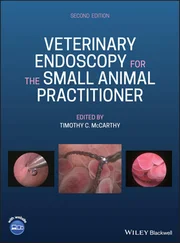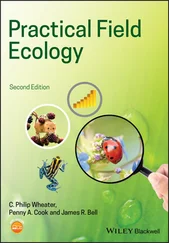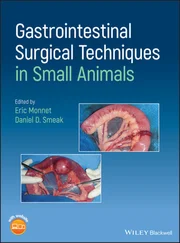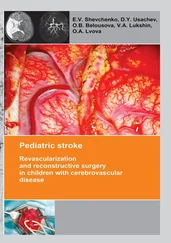1 Cover
2 Title Page
3 Copyright Page
4 Personal statements
5 Contributors
6 About the Companion Website
7 Part One: Pediatric Endoscopy Setting 1 Introduction 2 History of pediatric gastrointestinal endoscopy The precursors The fiberscope Training Evolution Conclusion REFERENCES 3 The endoscopy unit Unit design Unit management Equipment Conclusion REFERENCES 4 Pediatric procedural sedation and general anesthesia for gastrointestinal endoscopy Introduction Definitions/spectrum of sedation to general anesthesia Assessing risk in the pediatric patient Preparation Staffing and environment preparation During sedation and monitoring Postsedation care Conclusion FURTHER READING 5 Pediatric endoscopy training and ongoing assessment Introduction Training Assessment Conclusion REFERENCES 6 Recertification and revalidation as concepts in pediatric endoscopy REFERENCES 7 The role of the Global Rating Scale in pediatric endoscopy Introduction Pediatric endoscopy GRS The future REFERENCES FURTHER READING 8 Quality indicators as a critical part of pediatric endoscopy provision Introduction Conclusion REFERENCES 9 e‐learning in pediatric endoscopy USEFUL WEBSITES
8 Part Two: Diagnostic Pediatric Endoscopy 10 Indications for gastrointestinal endoscopy in childhood Introduction Diagnostic endoscopy Therapeutic indications for endoscopy 11 Diagnostic upper gastrointestinal endoscopy Introduction Indications for EGD Assembling the equipment and preprocedure check‐up Endoscope handling Preparation for esophageal intubation Techniques of esophageal intubation Exploration of the esophagus, stomach, and duodenum Biopsy technique pH and pH impedance probe placement Complications Uncommon, incidental, and rare findings during EGD FURTHER READING 12 Pediatric ileocolonoscopy Bowel preparation for colonoscopy Indications for ileocolonoscopy Contraindications for ileocolonoscopy Equipment Informed consent and preprocedure preparation Specifics of sedation for colonoscopy Embryology of the colon relative to ileocolonoscopy Endoscopic anatomy of the colon and terminal ileum Torque steering technique – the key to successful ileocolonoscopy Technique of ileocolonoscopy Complications Common pathology: rectal bleeding Rare pathology FURTHER READING 13 Handling of specimens and orientation of biopsies Introduction Specimen handling in the endoscopy unit Specimen handling in the histopathology laboratory REFERENCES 14 Enteroscopy Introduction Double‐balloon enteroscopy technique Single‐balloon enteroscopy Spiral enteroscopy Intraoperative or laparoscopy‐assisted enteroscopy General complications Conclusion FURTHER READING 15 Wireless capsule endoscopy Introduction Practical approach Pediatric experience and pathologies Recent developments Conclusion REFERENCES 16 Endoscopic ultrasonography Introduction Instruments and technique Indications in children EUS features in pediatric diseases REFERENCES 17 Chromoendoscopy Indications Application technique Recognition of lesions FURTHER READING 18 Confocal laser endomicroscopy in the diagnosis of pediatric gastrointestinal disorders Contrast agents Upper GI tract Lower GI tract Conclusion FURTHER READING 19 High‐risk pediatric endoscopy Introduction Patients at high risk for cardiopulmonary and sedation‐related events Patients at high risk for bleeding Patients at high risk for perforation Patients at high risk for endoscopy‐related infections Risk factors for procedure‐related infections REFERENCES
9 Part Three: Pediatric GI Pathologies and the Role of Endoscopy in Their Management 20 Esophagitis Introduction Infectious esophagitis Epidermolysis bullosa Esophagitis in Crohn's disease Chemotherapy and radiotherapy‐induced esophagitis Final considerations REFERENCES 21 Eosinophilic esophagitis Introduction Mucosal biopsy procurement Assessment of esophageal gross findings Therapeutic uses for endoscopy Future alternative devices for mucosal assessment Acknowledgments REFERENCES 22 Gastritis and gastropathy Introduction Infective gastropathy Reactive gastropathy Conclusion REFERENCES 23 Celiac disease Introduction Visual diagnosis, biopsy sampling, handling, and histopathology Future of endoscopy in pediatric CD REFERENCES 24 Role of endoscopy in inflammatory bowel disease including scoring systems Introduction Diagnosis Monitoring Scoring systems REFERENCES
10 Part Four: Therapeutic Pediatric Endoscopy 25 Endoscopic management of esophageal strictures Stricture presentation Classification Diagnosis Differential diagnosis Treatment REFERENCES 26 Endoscopic management of caustic ingestion Introduction Pathophysiology Clinical presentation Assessment and management Endoscopy Treatment Long‐term complications REFERENCES 27 Pneumatic balloon dilation and peroral endoscopic myotomy for achalasia Introduction Diagnosis and management of achalasia Therapeutic options Peroral endoscopic myotomy REFERENCES 28 Endoscopic approaches to the treatment of gastroesophageal reflux disease Introduction Endoscopic suturing devices EsophyX ® Delivery of radiofrequency energy (Stretta® system) Gastroesophageal biopolymer injection Conclusion FURTHER READING 29 Foreign body ingestion Introduction Diagnostic evaluation Esophageal impaction of a foreign body Foreign bodies in the stomach and small bowel Food bolus impaction Equipment and management approaches for foreign body removal REFERENCES 30 Non‐variceal endoscopic hemostasis Introduction General considerations Choice of endoscope Techniques of endoscopic hemostasis REFERENCES 31 Variceal endoscopic hemostasis Portal hypertension and variceal formation Diagnosis, classification, and risk stratification of varices Primary prophylaxis Secondary prophylaxis Gastric varices REFERENCES 32 Endoscopic approach to obscure gastrointestinal bleeding lesions Introduction Classification Evaluation and management of obscure gastrointestinal bleeding Diagnostic and therapeutic approach with enteroscopy Conclusion REFERENCES 33 Percutaneous endoscopic gastrostomy Introduction Indications Contraindications Decision to proceed with PEG and preprocedure evaluation Technique Postprocedure management Complications New uses of the PEG technique Conclusion FURTHER READING 34 Single‐stage percutaneous endoscopic gastrostomy Introduction Indications Contraindications Advantages of single‐stage PEG Drawbacks Technique Postprocedure management Complications Useful tips Materials Consent REFERENCES 35 Pediatric laparoscopic‐assisted direct percutaneous jejunostomy Introduction Conclusion FURTHER READING 36 Naso‐jejunal and Gastro‐jejunal tube placement FURTHER READING 37 Endoscopic retrograde cholangiopancreatography Introduction Duodenoscopes and accessories Performing ERCP in children Adverse events in pediatric ERCP Biliary indications for diagnostic and therapeutic ERCP Pancreatic indications for diagnostic and therapeutic ERCP Functional biliary sphincter disorder (previously sphincter of Oddi dysfunction; SOD) Conclusion FURTHER READING 38 Endoscopic drainage of pancreatic pseudocysts Pancreatitis Pancreatic pseudocysts REFERENCES 39 Duodenal web division by endoscopy FURTHER READING 40 Polypectomy Principles of electrosurgery Snare loops Routine polypectomy Complications FURTHER READING 41 Endomucosal resection Introduction High‐magnification chromoscopic colonoscopy Endoscopic mucosal resection Clinical recommendations and conclusions 42 Endoscopic management of polyposis syndromes Introduction and classification Familial adenomatous polyposis Juvenile polyposis syndrome Peutz–Jeghers syndrome 43 Transnasal gastrointestinal endoscopy Introduction Preendoscopy preparation Views and image quality Duration Success rates Patient comfort and preference Complications and safety profile Therapeutic use Future considerations Conclusion REFERENCES 44 Endoscopic bariatric approaches Introduction Intragastric balloons Duodenojejunal bypass liner Conclusion FURTHER READING 45 Over‐the‐scope clip and full‐thickness resection device FURTHER READING 46 Endoscopic treatment of gastrointestinal bezoars REFERENCES 47 Natural orifice transendoluminal surgery
Читать дальше
